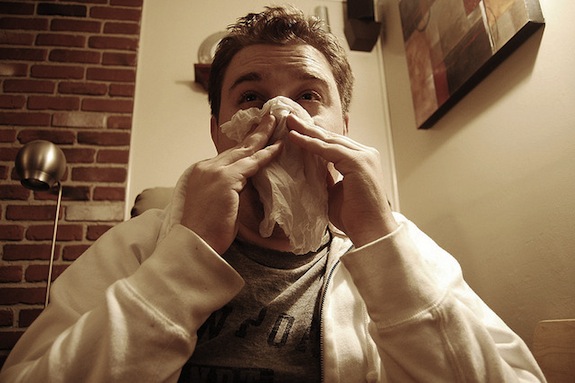Researchers Treat Sinusitis the Same Way They Clean Ships
Yes, researchers think about your nose like a dirty ship hull that needs cleaning. But it does seem to work

Image: Svenstorm
Since many of the common treatments for sinusitis come in the form of nasal spray, people suffering from this affliction—constant inflammation of the sinuses—are probably used to putting weird things in their noses. But what about a microbe that helps to clean the hulls of ships? It might sound a little crazy, but apparently these microbes might be able to treat the problem.
In a study published today in PLoS ONE, researchers isolated a marine bacteria called Bacillus licheniformis—a bacteria that grows on seaweed and works pretty well as a ship cleaner. Newcastle University writes:
When under threat, bacteria shield themselves in a slimy protective barrier. This slimy layer, known as a biofilm, is made up of bacteria held together by a web of extracellular DNA which adheres the bacteria to each other and to a solid surface – in this case in the lining of the sinuses. The biofilm protects the bacteria from attack by antibiotics and makes it very difficult to clear them from the sinuses.
But when the bacteria wants to move along, it has to break up that biofilm. It does so by releasing an enzyme called NucB that breaks up the external DNA. That enzyme is what the researchers are interested in. When they purified the enzyme and added it back to the pesky bacteria, it dissolved the biofilm and sent the bacteria scattering. (Well, 58 percent of them, at least.)
The marine bacteria that makes NucB has long been used by chemists for other things. The EPA even has a risk assessment for it that says:
It has been used in the fermentation industry for production of proteases, amylases, antibiotics, and specialty chemicals for over a decade with no known reports of adverse effects to human health or the environment. This species is easily differentiated from other members of the genus that are pathogenic to humans and animals. There are several reports in the literature of human infections with B. licheniformis, however, these occurred in immunosuppressed individuals or following trauma. There are no indications that B. licheniformis is pathogenic to plants. However, there are numerous reports in the literature of an association betweenB. licheniformis and abortions in livestock. In most reports, there were predisposing factors which may have resulted in immunosuppression of the affected animals. Since B. licheniformis is ubiquitous in the environment and appears to be an opportunistic pathogen in compromised hosts, the potential risk associated with the use of this bacterium in fermentation facilities is low.
And it’s been used for years to treat ornamental plants to prevent fungal diseases. There’s debate about whether or not the bacteria can make humans sick. Some sources report that the bacteria can spoil milk, canned goods and meats, resulting in some nasty food poisoning. But the majority of the time, the bacteria is totally safe to use on plants.
Applying the bacteria to human problems, however, is a more recent idea. Last year, researchers suggested brushing your teeth with the stuff to cut through plaque. The Daily Mail writes:
Professor Burgess, who led the research, said: ‘It’s an amazing phenomenon. The enzyme breaks up and removes the bacteria present in plaque and importantly, it can prevent the build up of plaque too.
‘When I initially began researching how to break down these layers of bacteria, I was interested in how we could keep the hulls of ships clear but we soon realised that the mechanism we had discovered had much wider uses.
‘If we can contain it within a toothpaste we would be creating a product which could prevent tooth decay.
Now those researchers are targeting other places where biofilms cause problems, like the nose of a sinusitis sufferer. Yes, researchers think about your nose like a dirty ship hull that needs cleaning. But it does seem to work.
More from Smithsonian.com:
/https://tf-cmsv2-smithsonianmag-media.s3.amazonaws.com/accounts/headshot/Rose-Eveleth-240.jpg)
/https://tf-cmsv2-smithsonianmag-media.s3.amazonaws.com/accounts/headshot/Rose-Eveleth-240.jpg)